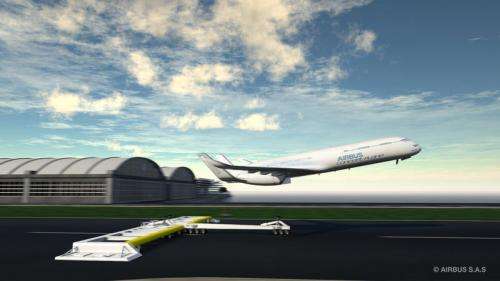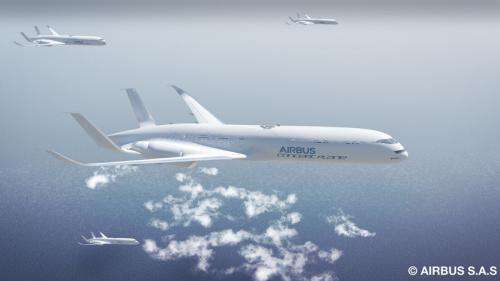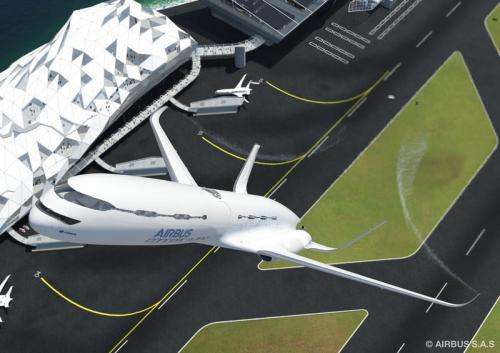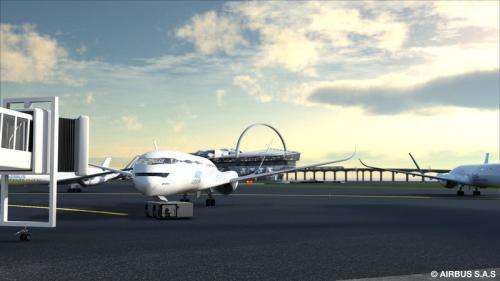September 6, 2012 report
Birds do it—Passenger planes will fly in formation too

(Phys.org)—Toulouse-based Airbus, a world-leading aircraft manufacturer, has issued its "vision" of what truly smart flying—smart, that is, as in sustainable rather than smart as in sensor-packed—will be like in 2050. The presentation is designed to address making passenger flying more comfortable, safer, more reliable, and, as key, to address the need to curb aviation emissions that pollute the environment. In all, Airbus has ideas for sustainable aviation in 2050 and beyond. If global air transport is to grow as projected, the company knows there is work ahead to cut emissions and institute ways that flying can be less burdensome to the environment. They are suggesting ways to minimize noise, reduce fuel emissions and potentially shorten flight times.
One such step foresees a new method for takeoff, with renewably powered propelled acceleration that allows aircraft to climb steeper and reach cruise altitude faster. They have suggested a propelled platform with its own set of wheels under the plane's fuselage that could boost acceleration before detaching just before takeoff.
In approaching airports, Airbus also suggested the plans could glide towards the airports using a steeper approach than usual as an alternative to the use of engine thrust and air brakes.
Their presentation looks at slowing aircraft at earlier stages and making shorter landing distances possible. Using shorter runways would mean less land use, also in the name of going green, or in the words of an Airbus statement, "as space becomes a premium and mega-cities become a reality."

Airbus further suggests that flying in formation be used to cut air drag and boost fuel efficiency. "High frequency routes would allow aircraft to benefit from flying in formation like birds during cruise bringing efficiency improvements due to drag reduction and lower energy use," according to the Vision statement.
Airbus executive vice president of engineering, Charles Champion, said "We know people want to fly more in the future and our forecasts support this. We also know that they don't want to fly at any cost."

Fuel is a key topic in the Airbus' proposal; Airbus says it is already working on development and use of alternative fuels. "The use of sustainable biofuels and other potential alternative energy sources (such as electricity, hydrogen, solar etc) will be necessary to secure supply and further reduce aviation's environmental footprint in the long term," said Airbus. This would allow an extensive introduction of regionally sourced renewable energy close to airports, the company added, feeding aircraft sustainably.

When you look at Airbus stats, it is easy to see that numbers in tons of excess fuel and avoidable CO2 emissions suggest that efforts to come up with smarter moves are needed. According to Airbus, if the Air Traffic Management system and technology on board the aircraft were optimized, then flights in Europe and the US could on average be around 13 minutes shorter, and flights in other parts of the world could be shorter too. Assuming around 30 million flights per year, this would save around 9 million tons of excess fuel annually, which equates to over 28 million tons of avoidable CO2 emissions and, for passengers, a saving of 5 million hours of excess flight time.
More information: www.airbus.com/no_cache/newsev … n-for-smarter-skies/
© 2012 Phys.org




















